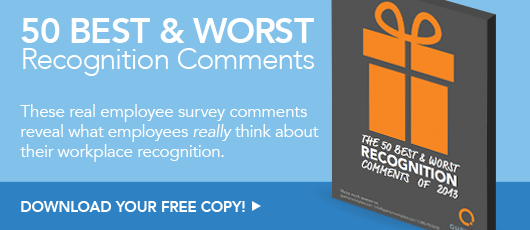What Type of Recognition Do Employees Want: How to Recognize Employees
 Employees are like snowflakes—no two are exactly the same. They have different personalities and varied backgrounds that shape who they are, how they work, and even how they prefer to be recognized.
Employees are like snowflakes—no two are exactly the same. They have different personalities and varied backgrounds that shape who they are, how they work, and even how they prefer to be recognized.
Many managers default to how they desire recognition, but this likely differs from the preferences of their employees. Some like to be praised publicly for all to see. More reserved employees appreciate quieter, private recognition.
You might think, “What’s the big deal? Recognition is recognition, right?” Not so fast. While most employees would like more appreciation, recognizing an employee in the wrong way can be off-putting and actually decrease engagement.
In this blog, we’ll cover how employees want to be recognized, the types of recognition they prefer, and how you can best show appreciation to drive employee engagement.
What type of recognition do employees want?
Recognition is more than just a pat on the back from a supervisor. In fact, there are many ways to recognize employees beyond a traditional review from a manager.
Here are a few types of employee recognition you can promote and incorporate into your team culture:
- Peer-to-peer recognition
- Manager-to-employee recognition
- Anonymous recognition
- Private recognition
- Public recognition
Each employee will respond to and appreciate different types of recognition. As you start learning what type of recognition your employees prefer, you’ll be able to develop a culture of recognition throughout your teams and organization.
How do employees want to be recognized?
So how do employees want to be recognized? This is the million-dollar question. And unfortunately, there’s no one right answer. Because every employee is different, each person will respond to and prefer different types of recognition.
Your job as a people leader is to figure out how your team and individual employees want to be recognized.
We recommend managers just come out and ask each employee, “How do you like to be recognized?”
The answer to this question uncovers:
- Whether the employee prefers public or private recognition.
- What types of work the employee wants to be recognized more. Do they get greater satisfaction from finding ways to be more efficient or expertly handling a difficult customer?
- When the employee wants to be recognized. Should you wait until the end of a major project or praise minor wins along the way to a greater goal?
- Whether the employee prefers individual or team accolades. Some love to be trumpeted as the team MVP, while others would rather highlight team efforts.
Get to know your employees on a personal level so you can determine which types of praise they appreciate the most. When you give recognition, pay attention to how they receive it. If they appear uncomfortable, try a different form of recognition the next time around.
Whatever approach you take, the key to success is authenticity. Recognition alone will not impact employee engagement. To drive engagement, recognition must be genuine and thoughtful. Yet only 56.4% of employees feel they receive thoughtful recognition from their manager.
Therefore, it's critical that managers take the time to be authentic with their recognition and appreciation efforts. The more you get to know your employees, the better you’ll understand how to recognize them.
How to recognize employees
Let’s get down to brass tacks. How do you actually make an impact with your recognition efforts? Here are a few ways to recognize your employees and show your appreciation.
Give regular performance feedback
It’s easy for managers to get lost in the weeds of day-to-day work and forget to incorporate regular feedback into their schedule. If you aren’t paying attention, you can miss those daily contributions that make a real difference.
That’s why it’s important to schedule regular, employee one-on-ones. Holding consistent performance conversations with your employees is key to building genuine relationships with your team—which lays the foundation for thoughtful and meaningful feedback and recognition.
Recognize achievements and effort
It’s easy to recognize tangible achievements. But don’t ignore incremental progress, improvement, and efforts from your employees. Wins are important benchmarks, but so is consistent effort.
Take time to show your appreciation for employees who keep showing up and trying. Let them know when you see improvement. This type of recognition helps employees feel seen, motivates them to continue striving towards their goals, and boosts morale.
Remember: No matter what type of recognition you currently give, a good place to start is by simply giving more recognition.
Our research found that 53% of employees want more recognition from their managers. And simple, public recognition is an effective foundation. Public praise not only boosts the employee receiving recognition but also signals to the team what behaviors or achievements are valued at your organization. This helps everyone align more clearly with company values and direct their work more strategically.
Genuine, personalized recognition helps drive engagement. Employees that feel valued by their managers are more likely to work harder, search for ways to improve and grow and stay with their organization. When you reward hard work, you not only energize the recognized employee, but you set an example for others in the organization of what good work looks like.
For great examples of ways to recognize employees (plus some bad ones to avoid), download our free ebook, The 50 Best and Worst Recognition Comments.







